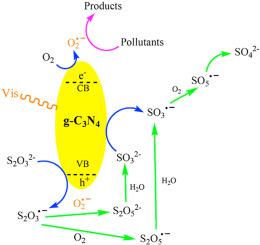Chemosphere ( IF 8.8 ) Pub Date : 2021-02-26 , DOI: 10.1016/j.chemosphere.2021.130119 Wenyu Zhang , Chuankun Yin , Yezi Jin , Xianjie Feng , Xiaoxia Li , Aihua Xu

|
Developing new strategies to design more practicable and efficient g-C3N4 based photocatalysts is important to solve the environmental issues. Thiosulfate (STS) is a common residual product found in wastewater and removal of STS remains a matter of great environmental concern. In this work, however, STS is activated by g-C3N4 under visible light irradiation, resulting in a fast degradation of Rhodamine B (RhB) and other pollutants. The performance of g-C3N4 prepared from urea was much higher than that from melamine, due to the higher surface area and more negative conduction band potential of the former catalyst. In addition, comparison with other oxidants and reductants such as peroxymonosulfate, peroxydisulfate, hydrogen peroxide and sulfite, the use of STS in g-C3N4/Vis system showed the highest efficiency for RhB degradation. During ten successive cycles, the excellent reusability of the catalyst was also obtained. The effect of different concentrations of STS and g-C3N4, and initial solution pH on the performance of the system were also studied. The mechanism study suggests that STS is first oxidized to S2O3 − radicals by photohole, which will be transformed to other oxysulfur radicals such as SO3
− radicals by photohole, which will be transformed to other oxysulfur radicals such as SO3 − and finally to SO42- ions. At the same time, the rate of O2 reduction by photoelectrons to O2
− and finally to SO42- ions. At the same time, the rate of O2 reduction by photoelectrons to O2 − radicals as well as RhB degradation increases. The finding of this study provides a promising advanced oxidation process for organic pollutants degradation via STS activation.
− radicals as well as RhB degradation increases. The finding of this study provides a promising advanced oxidation process for organic pollutants degradation via STS activation.
中文翻译:

硫代硫酸盐在可见光下用gC 3 N 4增强水溶液中有机污染物的降解
开发新的策略以设计更实用和有效的基于gC 3 N 4的光催化剂对于解决环境问题非常重要。硫代硫酸盐(STS)是废水中常见的残留产物,去除STS仍是一个严重的环境问题。然而,在这项工作中,STS在可见光照射下被gC 3 N 4激活,导致罗丹明B(RhB)和其他污染物的快速降解。gC 3 N 4的性能由尿素制备的树脂比由三聚氰胺制备的树脂要高得多,这是因为前者催化剂具有更高的表面积和更大的负导带电位。另外,与过氧化一硫酸盐,过氧化二硫酸盐,过氧化氢和亚硫酸盐等其他氧化剂和还原剂相比,在gC 3 N 4 / Vis系统中使用STS表现出最高的RhB降解效率。在十个连续循环中,还获得了极好的催化剂可重复使用性。还研究了不同浓度的STS和gC 3 N 4以及初始溶液的pH值对系统性能的影响。机制研究表明,STS首先被氧化至S 2 ö 3  -由光空穴基,它们将被转化为其它基团oxysulfur如SO 3
-由光空穴基,它们将被转化为其它基团oxysulfur如SO 3  -和最后以SO 4 2-离子。与此同时,O-率2减少由光电子至O 2
-和最后以SO 4 2-离子。与此同时,O-率2减少由光电子至O 2  -自由基以及罗丹明B降解增加。这项研究的发现为通过STS活化降解有机污染物提供了一种有前途的高级氧化方法。
-自由基以及罗丹明B降解增加。这项研究的发现为通过STS活化降解有机污染物提供了一种有前途的高级氧化方法。


























 京公网安备 11010802027423号
京公网安备 11010802027423号